Heat exchanger for the outer skin of an aircraft
a technology of heat exchanger and aircraft, which is applied in the direction of energy-saving board measures, lighting and heating apparatus, laminated elements, etc., can solve the problems of low current consumption, low air resistance, and low installation space requirements, so as to facilitate and improve the cooling through the heat transfer device and improve the cooling power
- Summary
- Abstract
- Description
- Claims
- Application Information
AI Technical Summary
Benefits of technology
Problems solved by technology
Method used
Image
Examples
Embodiment Construction
[0041]FIG. 1a generally shows the manner in which a heat transfer device 2 can be arranged on the outer skin 4 of an aircraft. In this embodiment the heat transfer device 2 is arranged on the interior 6 of the aircraft, whereas in the embodiment of FIG. 1b the heat transfer device 2 is positioned on the exterior 8 of the aircraft. In these different installation positions it should be noted that the heat transfer device 2 has to meet different mechanical requirements. If the heat transfer device 2 is arranged on the interior 6 of the aircraft, in particular cases the heat transfer device 2 must be designed to absorb structural loads acting on the fuselage. In the case of relatively large-area heat transfer devices 2, which is not unrealistic in view of large quantities of heat without active cooling units, for flush installation of the heat transfer device 2 to the outer skin 4, in some regions the fuselage structure which exists in those locations and that comprises frame elements,...
PUM
 Login to View More
Login to View More Abstract
Description
Claims
Application Information
 Login to View More
Login to View More - R&D
- Intellectual Property
- Life Sciences
- Materials
- Tech Scout
- Unparalleled Data Quality
- Higher Quality Content
- 60% Fewer Hallucinations
Browse by: Latest US Patents, China's latest patents, Technical Efficacy Thesaurus, Application Domain, Technology Topic, Popular Technical Reports.
© 2025 PatSnap. All rights reserved.Legal|Privacy policy|Modern Slavery Act Transparency Statement|Sitemap|About US| Contact US: help@patsnap.com



